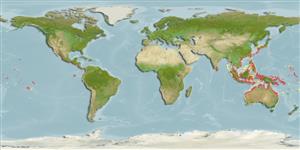Common names from other countries
Environment: milieu / climate zone / depth range / distribution range
Sinh thái học
Cùng sống ở rạn san hô; Mức độ sâu 0 - 5 m (Ref. 96667). Tropical
Indo-Pacific.
Length at first maturity / Bộ gần gũi / Khối lượng (Trọng lượng) / Age
Maturity: Lm ? range ? - ? cm Max length : 10.0 cm CW con đực/không giới tính; (Ref. 128968); Khối lượng cực đại được công bố: 100.00 g (Ref. 128968)
The carapace is bright orange in color with mosaic patterns. The walking legs have small hairs in their border (Ref. 128968)
Adults live along coral areas (Ref. 128968). This species is known to be one of the most poisonous crabs in the world. Its neurotoxin does not get denatured by heat even when cooked. It acquires the poisonous neurotoxin from its food, including a poisonous sea cucumber (Ref. 85383). Intertidal (Ref. 106854). Inhabits littoral and sublittoral areas with rocky and coral rubble substrates, and coral reefs (Ref. 85383).
Life cycle and mating behavior
Chín muồi sinh dục | Sự tái sinh sản | Đẻ trứng | Các trứng | Sự sinh sản | Ấu trùng
Members of the order Decapoda are mostly gonochoric. Mating behavior: Precopulatory courtship ritual is common (through olfactory and tactile cues); usually indirect sperm transfer.
Yeo, D.C.J., T. Swee Hee and P.K.L. Ng. 2008. (Ref. 85383)
IUCN Red List Status (Ref. 130435)
CITES status (Ref. 108899)
Not Evaluated
Not Evaluated
Threat to humans
Poisonous to eat (Ref. 85383)
Human uses
| FishSource |
Các công cụ
Các nguồn internet
Estimates based on models
Preferred temperature
(Ref.
115969): 22.8 - 29.3, mean 28.5 (based on 2762 cells).
